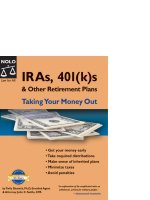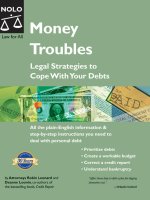solve your money troubles, debt credit and bankruptcy 13th (2011)
Bạn đang xem bản rút gọn của tài liệu. Xem và tải ngay bản đầy đủ của tài liệu tại đây (4.84 MB, 576 trang )
Free Legal Updates at Nolo.com
Money
Robin Leonard &
Attorney Margaret Reiter
• Stop illegal collection practices
• Create a realistic budget
• Get your fi nances under control
• Understand your bankruptcy options
13th Edition
OVER
100,000
SOLD
“Offers those deep in debt a plan for digging
themselves out.”
ORLANDO SENTINEL
Solve
Your
Debt, Credit
& Bankruptcy
Money
Troubles
N O L O
®
e Story
Dear friends,
Founded in 1971, and based in an old clock factory in
Berkeley, California, Nolo has always strived to off er clear
legal information and solutions. Today we are proud to
off er a full range of plain-English law books, legal forms,
software and an award-winning website.
Everything we publish is relentlessly researched and
tested by a dedicated group of in-house legal editors,
who together have more than 150 years’ experience. And
when legal changes occur after publication, we promptly
post free updates at Nolo.com.
Tens of millions of Americans have looked to Nolo to
help solve their legal and business problems. We work
every day to be worthy of this trust.
Ralph Warner
Nolo co-founder
Emma Cofod
Books & Software
Get in-depth information. Nolo publishes hundreds of great books
and software programs for consumers and business owners. ey’re all
available in print or as downloads at Nolo.com.
Legal Encyclopedia
Free at Nolo.com. Here are more than 1,400 free articles and answers to
common questions about everyday legal issues including wills, bankruptcy,
small business formation, divorce, patents, employment and much more.
Plain-English Legal Dictionary
Free at Nolo.com. Stumped by jargon? Look it up in America’s most
up-to-date source for defi nitions of legal terms.
Online Legal Documents
Create documents at your computer. Go online to make a will or living
trust, form an LLC or corporation or obtain a trademark or provisional
patent at Nolo.com. For simpler matters, download one of our hundreds
of high-quality legal forms, including bills of sale, promissory notes,
nondisclosure agreements and many more.
Lawyer Directory
Find an attorney at Nolo.com. Nolo’s unique lawyer directory provides
in-depth profi les of lawyers all over America. From fees and experience
to legal philosophy, education and special expertise, you’ll fi nd all the
information you need to pick a lawyer who’s a good fi t.
Free Legal Updates
Keep up to date. Check for free updates at Nolo.com. Under “Products,”
fi nd this book and click “Legal Updates.” You can also sign up for our free
e-newsletters at Nolo.com/newsletters/index.html.
Products
&
Services
“ In Nolo you can trust.”
THE NEW YORK TIMES
“ Nolo is always there in a jam as the nation’s premier publisher
of do-it-yourself legal books.”
NEWSWEEK
“ Nolo publications…guide people simply through the how,
when, where and why of the law.”
THE WASHINGTON POST
“ [Nolo’s]…material is developed by experienced attorneys who
have a knack for making complicated material accessible.”
LIBRARY JOURNAL
“ When it comes to self-help legal stuff , nobody does a better job
than Nolo…”
USA TODAY
“ e most prominent U.S. publisher of self-help legal aids.”
TIME MAGAZINE
“ Nolo is a pioneer in both consumer and business self-help
books and software.”
LOS ANGELES TIMES
e Trusted Name
(but don’t take our word for it)
L A W f o r A L L
Solve Your
Money Troubles
Debt, Credit & Bankruptcy
Robin Leonard, J.D., &
Attorney Margaret Reiter
13th edition
Thirteenth Edition APRIL 2011
Editor KATHLEEN MICHON
Book Design TERRI HEARSH
Cover Design SUSAN PUTNEY
Proofreading ROBERT WELLS
Index THÉRÈSE SHERE
Printing DELTA PRINTING SOLUTIONS, INC.
Leonard, Robin.
Solve your money troubles: debt, credit & bankruptcy / By Robin Leonard & Margaret
Reiter.—13th ed.
p. cm.
Includes index.
Summary: “A comprehensive guide for those on the brink of fi nancial crisis to manage
fi nances and get debt under control. The 13th edition includes information on the Credit
CARD Act and dealing with foreclosure”—Provided by publisher.
ISBN-13: 978-1-4133-1421-2 (pbk.)
ISBN-10: 1-4133-1421-X (pbk.)
ISBN-13: 978-1-4133-1423-6 (pdf e-book)
ISBN-13: 978-1-4133-1569-1 (epub e-book)
1. Debtor and creditor—United States—Popular works. 2. Credit—Law and legislation—
United States—Popular works. I. Reiter, Margaret. II. Title.
KF1501.L46 2011
346.7307'7—dc22
2010052779
Copyright © 1991, 1993, 1995, 1996, 1997, 2000, 2001, 2002, 2003, 2005, 2007, 2009, and
2011 by Nolo. All rights reserved. The NOLO trademark is registered in the U.S. Patent and
Trademark Offi ce. Printed in the U.S.A.
No part of this publication may be reproduced, stored in a retrieval system, or transmitted
in any form or by any means, electronic, mechanical, photocopying, recording, or
otherwise without prior written permission. Reproduction prohibitions do not apply to the
forms contained in this product when reproduced for personal use. For information on
bulk purchases or corporate premium sales, please contact the Special Sales Department.
Call 800-955-4775 or write to Nolo, 950 Parker Street, Berkeley, California 94710.
Please note
We believe accurate, plain-English legal information should help you solve many
of your own legal problems. But this text is not a substitute for personalized
advice from a knowledgeable lawyer. If you want the help of a trained professional—
and we’ll always point out situations in which we think that’s a good idea—consult
an attorney licensed to practice in your state.
Table of Contents
Your Legal Companion to Solving Your Money Troubles 1
1
How Much Do You Owe? 3
How Much Do You Earn? 5
How Much Do You Owe? 5
2
If You’re Married, Divorced, or Separated 9
Community Property States 11
Common Law States 14
3
Debts You May Not Owe 19
You Are the Victim of Misrepresentation or Other Fraud 20
e Seller Breached a Warranty 26
Your Car Is a Lemon 29
Home Mortgage Contracts 31
You Canceled a Contract 31
You Received Goods You Didn’t Order 36
You Don’t Want Goods on Layaway 37
Canceling Automatic Deduction Payments 37
You’ve Been “Slammed” by a Phone Company 39
You’ve Been “Crammed” by a Phone Company 40
4
Prioritizing Your Debts 43
Secured and Unsecured Debts 44
High-Priority Debts 46
Medium-Priority Debts 49
Low-Priority Debts 50
Review Your Worksheets 52
5
Negotiating With Your Creditors 53
Communicate With Your Creditors 55
Rent Payments 59
Mortgage Payments 60
Utility and Telephone Bills 62
Car Payments 63
Secured Loan Payments 65
Insurance Payments 67
Medical, Legal, and Other Service Bills 68
Child Support and Alimony Payments 68
Income Taxes 69
Student Loan Payments 70
Credit Card Payments 70
Negotiating When the Creditor Has a Judgment Against You 73
Pay Off a Debt for Less an the Full Amount 73
Don’t Write Postdated Checks 77
Beware of the IRS If You Settle a Debt 79
6
Finding Money to Pay Your Debts 81
Increase Your Income 82
Get Some of Your Tax Refund Early 82
Sell a Major Asset 83
Sell Smaller Items 84
Cut Your Expenses 86
Withdraw Money From a Tax-Deferred Account 89
Apply for Government and Agency Help 90
Consider a Home Equity Loan 93
Use the Equity in Your Home If You Are 62 or Older 95
Borrow the Money 99
Get Your Tax Refund Fast 100
What to Avoid When You Need Money 100
Avoid Bank and Credit Union Prepaid Cards With Advances 104
7
What to Expect When You Can’t Pay Your Debts 107
Eviction 108
Repossession 109
Tying Up Property Before a Lawsuit 116
Lawsuits 117
Lawsuits Against ird Parties Who Hold Your Assets 118
Liens on Your Property 118
Jail 120
Bank Setoff 120
Intercepting Your Tax Refund 120
Loss of Insurance Coverage 121
Loss of Utility Service 122
8
Reducing Mortgage Payments and Dealing With Foreclosure 123
Foreclosure 124
Overview of Nonjudicial Foreclosure 125
Judicial Foreclosures 126
e Sale 126
Defenses to Foreclosure 128
Watch Out for Deficiency Balances 130
Alternatives to Foreclosure 131
Short-Term Informal Payment Plans 133
Federal Programs for Homeowners Facing Possible Foreclosure 133
Mortgage Workouts 140
Refinancing 141
Selling Your House 144
Short Sales and Deeds in Lieu of Foreclosure 144
Other Programs to Help Homeowners 147
9
Dealing With Debt Collectors 149
Creditor or Collection Agency? 150
Negotiating Secured Debts 152
Before Your Debt Is Sent to a Collection Agency 152
When Your Debt Is Sent to a Collection Agency 154
Illegal Debt Collection Practices 166
How to Fight Back If a Collection Agency Violates the Law 169
10
Choosing and Managing Credit Cards 177
e Credit CARD Act 179
Credit Card Traps 186
Trouble Paying Your Bill 192
Using Credit Cards Wisely 193
Cards You Didn’t Request 198
Rejected and Blocked Cards 199
Liability If Your Credit Card Is Lost or Stolen 200
Unauthorized Use of Your Card by an Acquaintance 202
To Dispute a Credit Card Bill 203
Debit Cards 208
Prepaid Debit Cards 210
11
Understanding Loan and Other Credit Documents 211
Required Credit Disclosures 212
Terms of Credit Agreements 216
12
Student Loans 229
What Kind of Loan Do You Have? 231
Figuring Out Who Holds Your Student Loan 233
Canceling Your Loan 234
Postponing Payments 237
Repaying Student Loans 238
Getting Out of Default 242
Filing for Bankruptcy When You Can’t Pay 244
Consequences of Ignoring Student Loan Debt 245
Where to Go for Help 245
13
Child Support and Alimony 247
How Child Support Is Determined 248
Modifying the Amount of Child Support 250
If Paternity Is Disputed 254
Enforcement of Child Support Obligations 254
Alimony 261
Bankruptcy and Child Support or Alimony Debt 262
Taxes, Child Support, and Alimony 262
14
If You Are Sued 265
How a Lawsuit Begins 267
Negotiate 271
Alternative Dispute Resolution 275
Respond in Court 277
What to Expect While the Case Is in Court 287
When the Creditor Gets a Judgment Against You 292
Stopping Judgment Collection Efforts 298
15
Bankruptcy: e Ultimate Weapon 301
Kinds of Bankruptcy 303
Filing for Bankruptcy Stops Your Creditors 304
Chapter 7 Bankruptcy 307
Chapter 13 Bankruptcy 311
Will Bankruptcy Solve Your Debt Problems? 312
16
Property Creditors Can’t Take 317
Property Subject to Collection 320
Property Subject to the Bankruptcy Court’s Authority 325
Applying Exemptions 330
Is Your Property Exempt? 334
Turning Nonexempt Property Into Exempt Property 343
17
Rebuilding Your Credit 347
Avoid Overspending 349
Understand Credit Scores and Credit Reports 355
Clean Up Your Credit Report 359
Your Credit Score 371
Build Credit in Your Own Name 374
Ask Creditors to Consider Your Spouse’s Credit History 375
Use Existing or New Credit Cards 375
Open Deposit Accounts 380
Work With Local Merchants 381
Obtain a Credit Union or Bank Loan 382
Avoid Credit Repair Clinics 383
18
Illegal Credit Discrimination 393
Basic Protections 394
Sex Discrimination 395
Marital Status Discrimination 395
Sexual Orientation Discrimination 396
Race Discrimination 396
National Origin Discrimination 396
Age Discrimination 397
Postbankruptcy Discrimination 397
Your Rights to Notice Regarding Credit Decisions 398
If You Are Denied Credit or Offered Expensive Credit Terms 400
Lawsuits Based on Credit Discrimination or Notice Violations 402
19
Help Beyond is Book 403
Looking Up the Law 404
Lawyers 411
Debt and Credit Counseling Agencies 415
G
Glossary 421
Appendixes
A
Federal Agencies 425
Where to Complain About Credit Discrimination 425
B
Contact Information for Useful Agencies, Organizations,
and Other Entities
427
C
Federal and State Exemption Tables 431
D
Worksheets 499
Worksheet 1: Monthly Income 500
Worksheet 2: Your Debts 501
Worksheet 3: Property Checklist 504
Worksheet 4: Property Exemptions 508
Worksheet 5: Daily Expenses 514
Worksheet 6: Monthly Budget 516
Index 523
Sample Letters and Forms
Sample Letters Dealing With Fraud, Warranties, and
Unordered Goods
Sample Letter Asking for Refund Because of Misrepresentation or Fraud 22
Sample Complaint Letter to Government Agency 24
Sample Letter to Stop Paying After Failure to Repair on Warranty 28
Sample Letter Confirming Availability of Unordered Goods 38
Sample Letters to Landlords
Sample Letter Confirming Agreement With Landlord 47
Sample Letter to Landlord 60
Sample Letters to Creditors or Debt Collectors
(Negotiation or Debt Settlement)
Sample Letter to Creditors 57
Sample Letter to Creditor Confirming Agreement to Reduce
Payments Temporarily 58
Sample Letter Offering to Give Back Secured Property
in Exchange for a Written Agreement Waiving Deficiency 66
Sample Letter: Cashing Check Constitutes Payment in Full on
Disputed Amount (Outside of California) 74
Sample Letter: Cashing Check Constitutes Payment in Full on
Disputed Amount—First Letter (California) 75
Sample Letter: Cashing Check Constitutes Payment in Full on
Disputed Amount—Second Letter (California) 76
Sample Letter: Cashing Check Constitutes a Release of All Claims
When You Send Check for Less an Full Amount Owed 77
Sample Letter to Creditor or Debt Collector to Make Lump Sum
Payment If Negative Information Removed from Credit Report 164
Sample Letters Regarding Debt Collection
Sample Letter to Collection Agency Requesting Verification of Debt 159
Sample Letter to Collection Agency to Tell It to Cease Contacting You 160
Sample Letter to Creditor or Debt Collector to Make Lump Sum
Payment If Negative Information Removed from Credit Report 164
Sample Letter to Creditor About Debt Collector’s Improper Collection Tactics 170
Sample Letters to Credit Card Issuers
Sample Letter to Credit Card Issuer Canceling Card
(When You Have a Right to Cancel and Pay Over Time) 183
Sample Letter to Credit Card Issuer Canceling Card 185
Sample Letter Confirming Telephone Notice of Lost or Stolen Card 202
Sample Letter to Notify of Credit Card Billing Error 204
Sample Letter Raising Claim to Credit Card Bill 207
Sample Letter Asking for Basis of Unfavorable Credit Offer or Action 401
Sample Letters and Court Documents Dealing With Lawsuits
Sample Settlement Agreement or Release 273
Sample Letter to Creditor Requesting Mediation 277
Sample Answer (to Lawsuit) 285
Sample Proof of Service 288
“The so-called debtor class … are not
dishonest because they are in debt.”
—Grover Cleveland
22nd & 24th president of the United States, 1837–1908
I
f you have debt problems, you are not
alone. Millions of honest, hardworking
people have trouble paying their debts.
In recent years, these numbers have mush-
roomed. The 2008 recession spelled financial
disaster for the many Americans that lost
jobs and the health insurance that came with
those jobs, or had work hours drastically
reduced.
But there is good news. By knowing your
legal rights and asserting them, you can get
the bill collectors off your back and give
yourself a fresh financial start. Often, it’s
easier than you think to affirmatively deal
with your debt problems. Debtors who assert
themselves may get more time to pay, have
late fees dropped, settle debts for less than
the full amount, and even reestablish credit.
Solve Your Money Troubles can help you
take charge. This book:
Tells you how recent changes in the law can
help you.
Solve Your Money Troubles explains
the new federal consumer regulations and
laws, enacted in 2009-2010, that provide
more protections and benefits to consumers.
By knowing your rights under these new
laws, you can better prevent abusive credit
practices and take advantage of consumer
benefits.
Shows you how to protect your legal rights.
For example, Solve Your Money Troubles
explains in detail how to respond to a
lawsuit, wage attachment, car repossession,
foreclosure proceeding, or property lien. It
also explains the latest regulations and laws
passed as a result of the severe recession that
began in 2008, many of which will benefit
consumers like you.
Helps you understand your debts. If you
know how the law categorizes different
kinds of debts, you’ll know what kinds
of collection efforts you can expect from
different creditors and which negotiating
strategies you can try with them.
Shows you effective alternatives to bank-
ruptcy.
Bankruptcy is the right tool for many
people to deal with their debt problems,
but it’s not for everyone. Solve Your Money
Troubles shows you the steps you can take to
avoid bankruptcy when appropriate.
Gives you practical tips and information.
Solve Your Money Troubles contains over 20
sample letters and statements that you can
use to:
•getthebillcollectorsoffyourback
•askacreditorformoretimetopay,or
•askacreditortolowertheamountofa
bill.
Your Legal Companion to
Solving Your Money Troubles
2
|
SOLVE YOUR MONEY TROUBLES
Solve Your Money Troubles also refers you
to places to lodge a complaint or ask for
information, and contains charts of state laws
summarizing consumer laws, debt collection
laws, credit bureau regulations, and more.
Helps you evaluate your individual debt
situation.
Solve Your Money Troubles includes
several worksheets to help you figure out
how much you earn, how much you owe,
how much you spend, and what you own.
With these worksheets, you can prioritize
your debts, determine whether you are
judgment proof, and decide what approach
to take: Do nothing, negotiate with your
creditors, get outside help nego tiating, or
possibly file for bankruptcy.
●
How Much Do You Earn? 5
How Much Do You Owe? 5
C H A P t e r
1
How Much Do You Owe?
4
|
SOLVE YOUR MONEY TROUBLES
“There can be no freedom or beauty about
a home life that depends on borrowing and
debt.”
—Henrik Ibsen, Norwegian poet
and dramatist, 1828–1906
T
o successfully plan your strategies
with your creditors, you need to
come to terms with your total
amount of debt. This may make you shudder.
But happily, most credit counselors will
tell you that people tend to overestimate
their debt burdens.
To figure out your financial situation, you
need to compare what you bring in each
month with what you owe on your monthly
expenses (such as food, housing, and
utilities) and your other debts (for example,
student loan payments).
Having a ballpark idea of the amount of
your income and debt burden is not enough
to tackle your debt problem. Getting precise
numbers is a crucial part of the process—
don’t skip it. In addition to laying out how
much you earn and owe, this process will
help you prioritize your debts, which will
then help you decide which strategies to use
to solve your money troubles.
To figure out how much you earn and
how much you owe (both in monthly pay-
ments and overall), follow the instructions
on the next pages and use the worksheets
in Appendix D. If you are married or have
jointly incurred most of your debts with
someone, fill out the worksheets together.
Warning Signs of Debt Trouble
If you have panic attacks when you try to
figure out your total debt burden, you’ll feel
better if you skip this chapter and come back
to it when you are better able to confront the
information. Before doing that, however, ask
yourself the following questions. If you answer
“yes” to any one of them, you are probably in
or headed for serious debt trouble:
• Are your credit cards charged to the
maximum?
• Do you use one credit card to pay
another?
• Are you making only minimum pay-
ments on your credit cards while
continuing to incur charges?
• Do you skip paying certain bills each
month?
• Have creditors closed any accounts on
you?
• Have you taken out a debt consoli da-
tion loan? Are you considering doing
so?
• Have you borrowed money or used
your credit cards to pay for groceries,
utilities, or other necessities (for reasons
other than convenience or to get perks
on a credit card)?
• Have you bounced any checks?
• Are collection agencies calling and
writing you?
CHAPter 1
|
HOW MUCH DO YOU OWE?
|
5
How Much Do You Earn?
Start by figuring out how much you earn
each month. Grab a calculator, your
pay stubs, and complete Worksheet 1 in
Appendix D, by entering your monthly
income from each listed source. If you
are paid more often than monthly, see
the instructions in Worksheet 1 to convert
your pay to a monthly amount. If you have
income that doesn’t fit into one of these
categories, list it as “other.”
How Much Do You Owe?
In Worksheet 2 in Appendix D, you list your
debts. Gather the documents that show
payments on all your debts, the total amount
owed on each debt, and any amount past
due, including any interest or fees that have
been added. Be as thorough and complete as
possible. The completed Worksheet 2 will tell
you exactly how much you should be paying
each month (to be current on your debts)
and how far behind you are. Here’s how to
fill it out.
Column 1: Debts and other monthly living
expenses.
In Column 1, enter the type of
debt. Don’t enter a debt more than once.
So, for example, if you already deducted
from your income in Worksheet 1 a debt
that is paid out of your paycheck, such as
child support, don’t deduct that same debt
again here.
If you are married, you may not be
certain which debts are yours and which
belong to your spouse. If your marriage is
intact and you’re having mutual financial
problems, approach your debt problems
as a team. That is, enter all your debts in
Column 1. If, however, you are separated
or recently divorced, or are married but
having financial problems of your own, see
Chapter 2 for help on figuring out the debts
for which you are obligated. If you generally
share expenses and maintain a household
with someone else, consider combining
your income and paying all of your debts
with joint funds, regardless of who actually
incurred the debt. Enter both partners’ debts
in Column 1.
Column 2: Outstanding balance. In Column
2, enter the entire outstanding balance on
the debt. For example, if you borrowed
$150,000 for a mortgage and still owe
$125,000, enter $125,000. If you don’t want
to contact the creditor until you are ready
to negotiate (and that will only be after
you’ve determined how much you can pay),
you have a few options. Your latest account
statement might list the entire outstanding
balance. If not, the creditor’s automated
telephone system or online account
information might provide the information
you need. If you can’t get the balance and
you prefer not to talk to the creditor, use
your best guess for now.
Columns 3 and 4: Monthly payment and total
you are behind.
In Columns 3 and 4, enter
the amount you currently owe on the debt.
If the lender has not established set monthly
payments—for example, for a doctor’s
bill—enter the entire amount of the debt
in Column 4 and leave Column 3 blank. If
the debt is one for which you make regular
monthly payments—such as your car loan or
mortgage—enter the amount of the monthly
6
|
SOLVE YOUR MONEY TROUBLES
payment in Column 3 and the full amount
you are behind (monthly payment multiplied
by the number of missed months, plus any
fees or charges that have been added, like
over-limit fees or late payment charges) in
Column 4.
For credit card, department store, and
similar debts, enter the monthly minimum
payment in Column 3 and your entire
balance in Column 4. But keep in mind that
eventually you should make more than the
minimum payment on your credit cards.
(Chapter 10 discusses the danger of making
only minimum payments each month.)
Column 5: Is the debt secured? In Column 5,
indicate whether the debt is secured or
unsecured. A secured debt is one for which a
specific item of property (called “collateral”)
guarantees payment. The most common
type of secured debt occurs when you sign a
credit agreement (sometimes called a security
agreement) that allows the creditor to take
a particular item of property under certain
specified conditions—without suing you first.
Examples of conditions that might allow the
creditor to take your property include your
failure to make a payment, your failure to
maintain insurance on the property, or your
failure to comply with the payment agreement
in some other way. Typically you sign a credit
agreement, giving the creditor a security
interest in your property when you finance a
car purchase; get a mortgage; get a second,
third, or additional loan on your home; or buy
an appliance or piece of furniture with store
credit.
A creditor may also be able to secure its
debt without your agreement by filing a lien
against your property. This can happen in
two circumstances. First, the creditor can
file a lien if the law specifically allows for it.
An example is a mechanic’s lien—the law
specifically states that a worker or material
supplier may file a lien against your real
property if you or the contractor fail to
pay them. Second, a creditor can file a lien
against your property if it has sued you and
obtained a judgment against you. This is
called a judgment lien.
Unsecured debts are typically bank credit
card debt; bills owed for utilities, medical, or
legal services; student loans; and spousal or
child support.
Secured property is usually something
very important, like your car or house.
Because it can be taken quickly, without the
delay of a lawsuit, secured debts are usually
a high priority for you to pay.
Specify the collateral the creditor is
entitled to grab if you default. (After you
have read more about whether a debt is
secured or not in Chapter 4, you can come
back and review Column 5 to see if you
need to make any changes.)
Column 6: What priority is the debt? Leave
Column 6 blank until you read Chapter 4. It
will help you prioritize the debts.
Add it up. When you’ve entered all your
debts in the worksheet, total up Columns
2, 3, and 4. Column 2 represents the total
balance of all your debts, even though
some of it may not be due now; Column 3
represents the amount you are obligated to
pay each month; and Column 4 shows the
amount you would have to come up with to
get current on all your debts.
CHAPter 1
|
HOW MUCH DO YOU OWE?
|
7
RELATED TOPIC
Don’t forget your other expenses.
None of us have monthly expenses consisting
entirely of loan or credit payments. We also have
to pay rent and buy groceries, pay for movies and
restaurants, buy clothing and household goods,
and so on. ese other expenses are covered in
Chapter 17. Now might be a good time to review
the information in Chapter 17’s “Figure Out
Where Your Money Goes.” By listing your non-
debt-payment expenditures, you will get a more
complete picture of your finances.
●
C H A P t e r
2
If You’re Married, Divorced,
or Separated
Community Property States 11
Who Owes What Debts? 11
Who Owns What Property? 12
What Property Is Liable for Payment of Debts? 13
Separate Property 14
Community Property 14
Common Law States 14
Who Owes What Debts? 14
Who Owns What Property? 15
What Property Is Liable for Debts? 16









